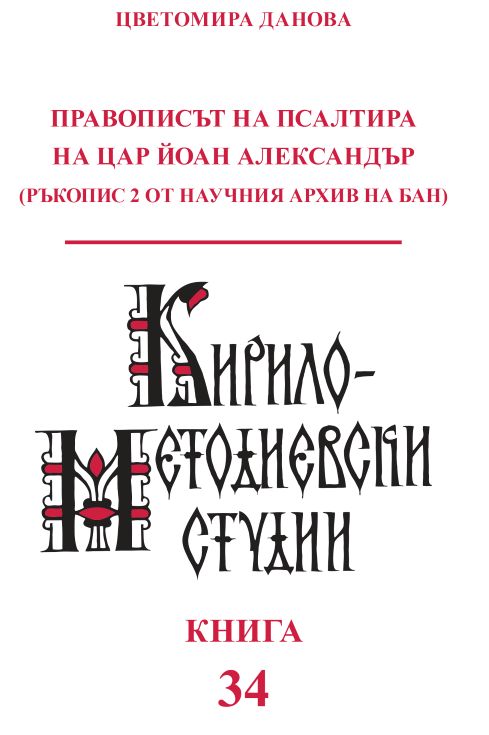Правописът на псалтира на цар Йоан Александър (ръкопис 2 от Научния архив на БАН) (= Кирило-Методиевски студии. Кн. 34)
The Orthography of the Psalter of Tsar Ivan Alexander (Ms 2 of the Scientific Archive of the Bulgarian Academy of Sciences) (= Cyrillo-Methodian Studies. 34)
Author(s): Tsvetomira Danova
Subject(s): Language studies, Language and Literature Studies, Theoretical Linguistics, Historical Linguistics, South Slavic Languages, Philology
ISSN: 0205-2253
Published by: Кирило-Методиевски научен център при Българска академия на науките
Keywords: Sofia Psalter (Pesnivets); MS NA-BAN 2; Tsar Ivan Alexander; Orthography
Summary/Abstract: The monograph is dedicated to the orthographic features of the Sofia commentated Psalter from 1337 (MS NA-BAN 2), also known as the Psalter of Tsar Ivan Alexander. The aim is to describe the orthographic practices of each identified scribe in as much detail as possible and compare the general and specific characteristics of the different orthographic types they followed.A detailed analysis has been conducted on the following graphemes and allographs used by the copyists: е (є), ꙃ (ꙅ, ѕ), (і, ї), о (ѻ, ѡ, ꙩ, ) ѹ (, ), ъ, ь, ы, ѫ, ѭ, ѧ (ꙙ), ѩ (ꙝ), ѣ, ꙗ, , ѯ, ҁ, ѳ, у/ѵ, ѱ. The study also examines the use of the epenthetic l, supralinear signs, and the orthography of Greek loanwords. Observations on the orthography of the manuscript are based on a comprehensive excerpting of material according to the specified criteria, including from the two folios of the codex that are part of P. I. Shchukin’s collection in the State Historical Museum in Moscow (GIM, Shchukin 3). In four chapters, the orthographic characteristics of each of the four scribes involved in the creation of the manuscript are presented sequentially and in detail. The orthographic features of a small excerpt identified with a fifth handwriting are also examined separately. Three appendices illustrate the use and distribution of selected graphemes and allographs in the codex, as well as the orthography of personal and geographical names in an Old Bulgarian-Greek index with lemmatization and in two lists: Old Bulgarian-Greek and Greek-Old Bulgarian. The present study reveals four orthographic systems that combine characteristics typical of the period with individual orthographic habits. Many orthographic rules are not consistently applied, exhibit a non-mandatory nature, and are in the process of development and codification, which corresponds to the pre-Euthymian period during which the manuscript was created (1337). Despite the collective effort in the creation of the codex, there is no unified or comprehensive orthographic concept; each scribe retains and applies their individual training and background during the process. This provides additional insight into the working practices in literary centers during the first half of the 14th century and contributes to a clearer understanding of the different types of Middle Bulgarian orthography, particularly those associated with pre-Euthymian orthographic models and manuscripts written for or commissioned by Tsar Ivan Alexander.
Series: Кирило-Методиевски студии
- Print-ISBN-13: 978-954-9787-42-9
- Page Count: 168
- Publication Year: 2024
- Language: Bulgarian
- eBook-PDF
- Table of Content
- Introduction

